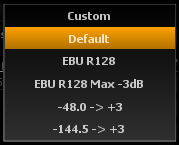True peak metering
All digital audio wave signals are ultimately converted back to analog at some point, and while it is often desirable to maximize the overall volume of a signal or a complete mix, care must be taken in order not to go above the digital scale zero decibel ceiling, or nasty distortion and clipping will occur. This common and widely used rule is however not entirely sufficient, as the digital and analog processing involved in a D/A converter does not guarantee that a 0dBfs peak signal will exactly translate to a 0dB peak in the analog domain.
Without getting into too much detail, this phenomenon can be attributed to the over-sampling and reconstruction filters present in the D/A convertors, whose role are to rebuild a continuous time signal from a set of discrete digital values sampled at regularly spaced time intervals. This interpolation process can therefore generate values which lie above 0dB, which is known as overshoot.
Relying solely on the peak value of samples can lead to the following problems:
- Inconsistent readings between successive playbacks of the same material.
- Unexpected overloads of the D/A output converter.
- Under-readings and beating of pure tones.
TruePeak metering aims to overcome these limitations by mimicking parts of the D/A conversion process, effectively up-sampling the measured signal, in order to display the true value of peaks that occur in the analog domain.
Preset
Custom
User defined values.
Default
This preset uses the following all-round settings:
Range: -72 … +3 dB referenced at 0dB.
Scale: 1.8x power factor, 0.06x reference display offset.
Ballistics: 16dB/s release time, 1dB/s peak release, 60 frames peak hold.
Scale / split: -72, -40, -18, -9, -6, -1, 0, +1, +3 dB.
EBU R128
Referenced at -1dB.
EBU R128 Max -3dB
Referenced at -3dB.
-48.0 -> +3
Limited -48 … +3dB range with adapted scale/split values.
-144.5 -> +3
Wide -144.5 … +3dB range with adapted scale/split values, to monitor the full 24-bit dynamic range and possible clipping.
Settings
Range
Min / max
Defines the minimum and maximum values to be displayed on the meter bars. This does not affect the text readings above the bars.
Ref
Controls the position of the reference value on the display. This does not affect the meter values per se, it is a cosmetic setting only.
Scale
Power factor
Controls the scaling of the display with respect to meter values. This allows to stretch or compress the display around Reference.
Ref pixel offset factor
Adjusts the offset of the reference value (Reference) with respect to meter height.
Time
Release
Release speed of the meter in decibels per second.
Peak release
Release speed of the peaks in decibel per second.
Peak hold
Number of frames to hold the peaks, before the actual release phase begins. 60 frames corresponds to 1 second on a fast system, capable of a 60Hz refresh rate.
Infinite hold
When enabled, peaks are held until the next reset, which is useful for checking a whole track never clips.
Reset
 button resets the meter to its initial state (values and peaks at minimum).
button resets the meter to its initial state (values and peaks at minimum).
Scale & split
Scale
Meter labels are defined here as a comma separated list of dB values to be shown on the side of the meters. This also defines where to the corresponding horizontal markings. Default is -72;-40;-18;-9;-6;-3;-1;0;1;3.
Colors
This lets you customize the values at which color transitions occur. You can enter as many values as you wish, as a comma separated list, but make sure the values are in increasing order. Default is -9;0.
The last value always defines the clip level, which will be indicated in red.
Other
Controls whether meters are drawn with texture or in a plain solid color. Default is on.

